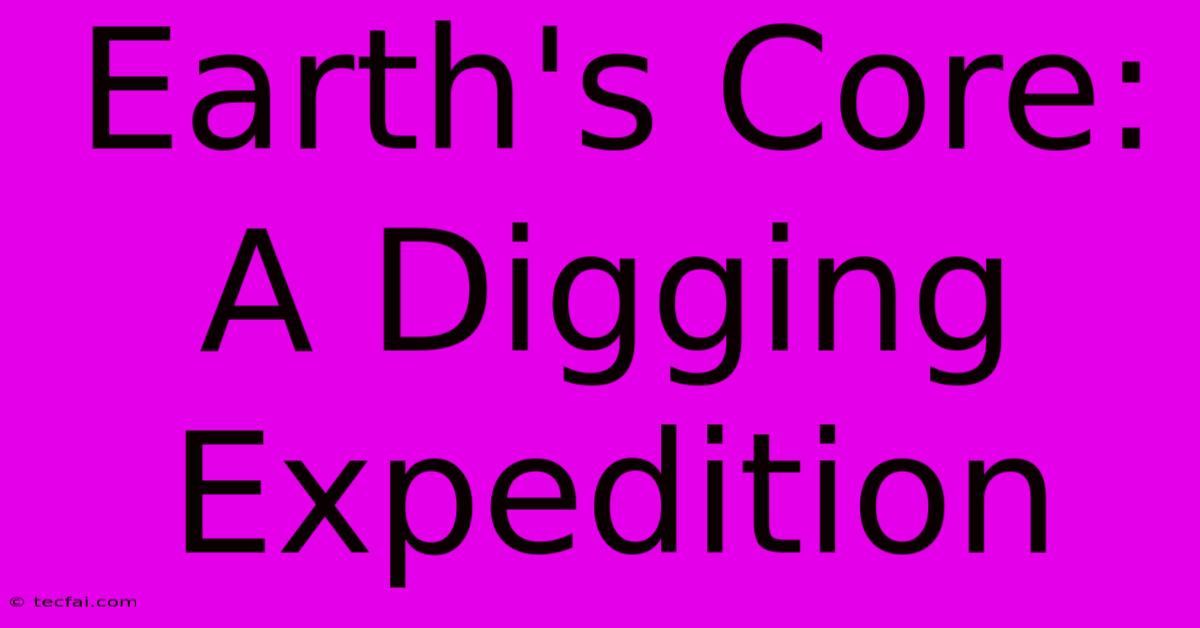Earth's Core: A Digging Expedition

Discover more detailed and exciting information on our website. Click the link below to start your adventure: Visit Best Website tecfai.com. Don't miss out!
Table of Contents
Earth's Core: A Digging Expedition – Exploring the Unknowns of Our Planet
The Earth, our home, is a dynamic sphere of incredible complexity. While we've explored the vast expanse of space and delved into the microscopic world, a significant portion of our own planet remains frustratingly out of reach: the Earth's core. This article embarks on a metaphorical "digging expedition," exploring what we know, what we don't, and the exciting possibilities of future research into this enigmatic realm.
Peering into the Earth's Interior: Layers of Mystery
Before we delve into the core itself, let's briefly review the Earth's layered structure. Our planet is comprised of several distinct layers:
- Crust: The outermost, thinnest layer, where we live. It's relatively rigid and fragmented into tectonic plates.
- Mantle: A thick, predominantly solid layer composed of silicate rocks. Convection currents within the mantle drive plate tectonics.
- Outer Core: A liquid layer composed mainly of iron and nickel. Its movement generates Earth's magnetic field, a crucial shield against harmful solar radiation.
- Inner Core: A solid sphere, also primarily iron and nickel, despite the immense temperatures and pressures. Its solidity is due to the incredible pressure.
The Inner Sanctum: Unraveling the Secrets of the Earth's Core
The Earth's core, particularly the inner core, is a realm of extreme conditions. Temperatures are estimated to reach around 5,200° Celsius (9,392° Fahrenheit), hotter than the surface of the sun! The pressure is immense, millions of times greater than at sea level. Direct observation is impossible with current technology; our understanding relies heavily on indirect methods.
Indirect Methods: How We Study What We Can't See
Scientists utilize several ingenious methods to study the Earth's core:
- Seismic Waves: Analyzing how seismic waves from earthquakes travel through the Earth provides crucial information about the core's composition, density, and state (solid or liquid). These waves refract and reflect, revealing the boundaries between layers.
- Magnetic Field Studies: The Earth's magnetic field, generated by the movement of the liquid outer core, is constantly monitored. Variations in the magnetic field provide insights into the dynamics of the core.
- Mineral Physics and Laboratory Experiments: Scientists recreate the extreme pressure and temperature conditions of the Earth's core in laboratories to study the behavior of iron and other materials under such intense conditions. This helps them model the core's properties.
Mysteries Remain: Open Questions about the Earth's Core
Despite significant advancements, many questions about the Earth's core remain unanswered:
- Inner Core Rotation: Evidence suggests the inner core rotates slightly faster than the rest of the planet. The exact mechanism and implications of this rotation are still being investigated.
- Core Formation and Evolution: Precisely how the core formed billions of years ago and how it has evolved over time is still a subject of debate.
- The Role of the Core in Plate Tectonics: The connection between the core's dynamics and plate tectonic movements is not fully understood.
- The Magnetic Field's Future: Understanding the long-term stability and potential fluctuations of Earth's magnetic field is critical, as it protects our planet from harmful solar radiation.
Future Explorations: The Next Chapter in Core Research
Future research will undoubtedly rely on technological advancements. Improved seismic networks, more sophisticated computer modeling, and potentially even new techniques are needed to unlock more of the core's secrets. Exploring the Earth's core is not just a matter of scientific curiosity; it's crucial for understanding our planet's past, present, and future. It holds the key to understanding crucial processes like plate tectonics and the generation of our protective magnetic field. The "digging expedition" continues, promising exciting discoveries in the years to come.

Thank you for visiting our website wich cover about Earth's Core: A Digging Expedition. We hope the information provided has been useful to you. Feel free to contact us if you have any questions or need further assistance. See you next time and dont miss to bookmark.
Featured Posts
-
The Agency Michaels Season 1 Debut
Nov 30, 2024
-
Film Review The Agency Fassbender
Nov 30, 2024
-
Meralco Lumigtas Nadaig Ang Phoenix
Nov 30, 2024
-
Fassbenders Spy Show Smart Fast Starry
Nov 30, 2024
-
Oti Mabuse Next I M A Celeb Queen
Nov 30, 2024
